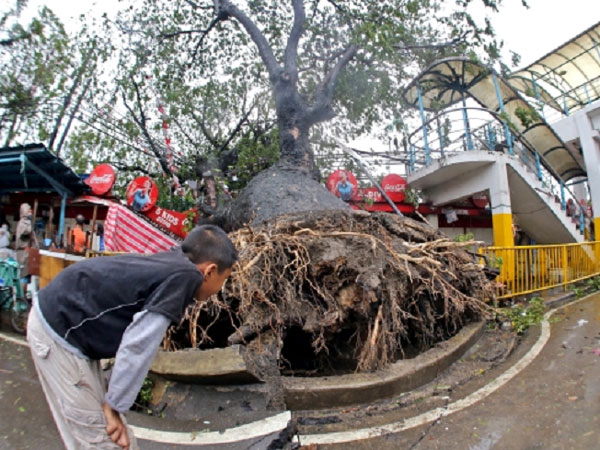Deadliest typhoons in the Philippines

Unidentified boy manage to look at the roots of a fallen acacia tree infront of Mabolo church due to typhoon yolanda no ones reported hurt during the fall.(CDN PHOTO/LITO TECSON)
MANILA, Philippines—Supertyphoon “Yolanda” (international name Haiyan) smashed into the Philippines on Friday, the latest in a never-ending pattern of storms for the developing Southeast Asian nation.
“Three hours before landfall, the Joint Typhoon Warning Center assessed Haiyan’s sustained winds at 314 kilometers per hour, gusting to 378 kph, making it the 4th strongest tropical cyclone in world history,” Dr. Jeff Masters co-founder of Weather Underground, a commercial weather service based in the United States, said.
“Thus, Haiyan had winds of 190 – 195 mph at landfall, making it the strongest tropical cyclone on record to make landfall in world history,” Masters said.
He said the previous record was held by the Atlantic’s Hurricane Camille of 1969, which made landfall in Mississippi with 190 mph winds.
But the strongest cyclone in history in terms of winds was Super Typhoon Nancy, which whipped Japan in 1961. It packed maximum sustained winds of 346 kph. It made landfall as Category 2.
Article continues after this advertisementYolanda, described as an equivalent of a Category 5 hurricane in US standards, was accompanied by torrential rainfall, violent winds and dangerous storm surges. It made landfall at its peak strength.
The archipelago of more than 7,100 islands is hit by an average of 20 typhoons or tropical storms each year, which kill hundreds and sometimes thousands of people.
The storms are created above the warmer waters of the Pacific Ocean near the equator, and the Philippines’ islands are often the first major landmass they hit as they move northwest.
Some government authorities say climate change is increasing the ferocity and frequency of the typhoons. Haiyan is one of the strongest ever recorded in the world, and is the Philippines’ 24th tropical storm or typhoon of the year, exceeding the annual average.
However some scientists say it is premature to blame climate change, and the Philippines has endured many devastating typhoons that have each claimed many hundreds of lives.
The following are the 10 deadliest typhoons on record in the Philippines*.
1. Tropical Storm Thelma unleashes flash floods on the central city of Ormoc on Leyte island on November 15, 1991, killing more than 5,100.
2. Typhoon Bopha smashes into the main southern island of Mindanao on December 3, 2012. Rarely hit by major storms, the unprepared region suffers about 1,900 people dead or missing.
3. Typhoon Ike hits the central Philippines on August 31, 1984, killing 1,363 people.
4. Typhoon Washi hits the northern part of Mindanao island on December 16, 2011, killing at least 1,080 people.
5. Floods and landslides unleashed by Typhoon Trix kill 995 people in the Bicol region of the main island of Luzon on October 16, 1952.
6. Typhoon Amy rakes across the central islands from December 9, 1951, killing 991 people as it unleashed floods and landslides and caused a massive storm surge that destroyed large sections of Negros island’s west coast.
7. Storm surges struck the eastern city of Legazpi on November 25, 1987 as Typhoon Nina roared into the Bicol region, where it also unleashed deadly mudslides down Mayon volcano. The disaster caused 979 deaths.
8. Typhoon Fengshen tracked an erratic and destructive path across the central islands and nearby areas from June 20, 2008, killing 938 people.
9. Typhoon Angela, one of the strongest storms to ever hit the Philippines with gusts of up to 260 kilometres an hour, caused carnage in Bicol and later Manila from November 2, 1995, killing 936 people.
10. Typhoon Agnes struck the central islands from November 5, 1984, killing 895 people.
* Data is on government records and those compiled by David Padua, a meteorologist for weather forecasting website The Weather Philippines Foundation.